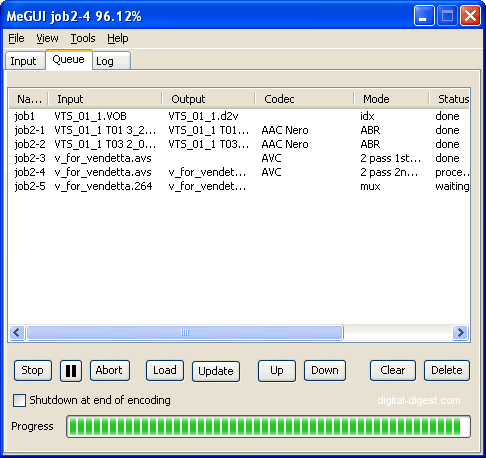MeGUI is one of the newer tools that has been designed with H.264 encoding in mind, while supporting other types of conversion, such as XviD. This guide shows you how to encode a H.264 (MP4) using MeGUI from a DVD as the primary example (instructions for converting other types of video files are also included).
This guide is aimed at intermediate users, basically users that are familiar with DVD conversion/backup and want to experiment with H.264 and MeGUI. As such, basic knowledge of DVD ripping and conversion is required, although brief instructions will be provided in any case.
Software you'll need (all freeware):


 Step 1: Installation
Step 1: Installation
The first thing you need to do before you can even install MeGUI is to download and install
Microsoft's .NET Framework version 2.0. It's a fairly large file and installation could take more than half an hour. Once you have it fully installed, you can now go on and download MeGUI.
Download MeGUI and install it. Start it up and most likely, it will prompt you to update the software used by MeGUI - click "Yes" to launch the update Manager.
Press the "Update" button to start the update process - MeGUI will automatically download and launch the install for the required software. You will most likely get a "1 file had problems" error, this is because the "neroaacenc" software cannot be downloaded automatically from MeGUI due to copyright reasons (it is freeware, but you need to go through Nero's software agreement first before you can download it). If you need to update "neroaacenc", go to
this page, select "Agree" to download the ZIP archive and extract the .exe files (in the win32/ folder in the ZIP archive) to your "megui\tools\neroaacenc" folder (eg. "c:\program files\megui\tools\neroaacenc\neroaacenc.exe").
When all the updates are completed, you can now close the MeGUI updater.
If you are converting from a commercial DVD source, you will need to rip the DVD to your hard-drive using RipIt4Me. RipIt4Me (and tools required by it) also needs to be installed - you can either follow the instructions in the
RipIt4Me guide or follow step 1 of our
Quick and Dirty DVD Backup Guide (you can skip installing ImgBurn and DVD Shrink, just install DVD Decrypter, RipIt4Me and FixVTS).
And we're now finished with the installation. If you are converting from a commercial DVD source, please proceed to the next page/step (Step 2: DVD Ripping). If you are converting from MPEG-2 (but not from a commercial DVD), please skip to step 3 (Step 3: D2V Creator). For all other video formats (eg. AVI,
 Step 2: DVD Ripping
Step 2: DVD Ripping
 Step 3: D2V Creator
Step 3: D2V Creator
 Step 4: AviSynth Script Creator
Step 4: AviSynth Script Creator
 Step 5a: Video Encoding Options MP4
Step 5a: Video Encoding Options MP4
 Step 5b: Video Encoding Options XVID
Step 5b: Video Encoding Options XVID

After the AviSynth Script Creator window closes, it will be entered in the AviSynth Script box on the Input tab. Below that is the output file. Click the button to the right of it to change the location or name. Select the dropdown menu next to Codec and set it to XviD. File Format should be set to AVI, MKV, or RAWASP (MP4). To select a Video Profile, determine what percentage of original DVD's bitrate will be used for the XviD encode. If you're not sure, compare the combined size of the VOB files to the intended final size of the XviD. The profiles are named by what amount of compression they're designed for. For example, XviD '>90% comp. check' means it's for encodes that are 90% as big as the original or more. Find the largest percentage that's smaller than or equal to the amount of compression your encode will have. Each compression level will have a fast and HQ option. As the names suggest, one will give you faster encodes, and the other a little higher quality.
 Step 6: Audio Encoding Options
Step 6: Audio Encoding Options
 Step 7: AutoEncode and starting the encoding
Step 7: AutoEncode and starting the encoding
We're nearly finished. Press the "AutoEncode" button to launch the Automatic Encoder setup windows.
This is pretty straight forward - just specify the output size of your video file (and make sure the Container is set correctly, to "MP4" for the purpose of this guide). The output location can be changed as well - this file will be the final output file that you want, so make sure you remember where you put it and don't accidentally delete it when cleaning up (I like to put this file in a different folder to all the other files, just in case). Press the "Queue" button and all the necessary jobs will be added to the encoding queue.
Click on the "Queue" tab and all the jobs should be listed there. An explanation of the queued jobs shown in the screenshot below:
- job1: D2V Creation (already finished)
- job2-1: Encoding audio track 1
- job2-2: Encoding audio track 2
- job2-3: Encoding video, 1st pass
- job2-4: Encoding video, 2nd pass
- job2-5: Muxing audio and video to MP4

When you're ready to start, press the "Start" button to start the encoding and when it's all finished, your MP4 file should be ready. You can delete all the other files, unless you plan on making more encodings from them.
We're done

 MeGUI Custom x264/AVC video profiles. (Updated: 2006-12-21)
Url to this pages:
http://nade.dk/web/nade/site.nsf/FramesetHP?readform&wmain=files/Megui
MeGUI Custom x264/AVC video profiles. (Updated: 2006-12-21)
Url to this pages:
http://nade.dk/web/nade/site.nsf/FramesetHP?readform&wmain=files/Megui